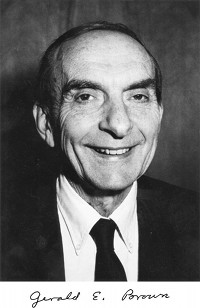
Gerald E. Brown
July 22, 1926 - May 31, 2013
Gerald (Gerry) Brown, a theoretical physicist who played a key role in the development of modern atomic and nuclear physics, died at his home in Setauket, New York on May 31. Brown was SUNY Distinguished Professor Emeritus with the Department of Physics and Astronomy and the C.N. Yang Institute for Theoretical Physics. His influential research began in the years following World War II, as physicists turned from war work to fundamental research, delving deeper and more precisely into the motion of electrons in atoms and the internal structure of atomic nuclei. Gerry and coworkers showed how to solve the then still novel equations of quantum mechanics and relativity to calculate the energies of electrons in atoms to new levels of accuracy, and to create novel methods to derive the properties of nuclei. These methods are still in use today. In later years, he went on to apply his understanding of nuclear physics to the formation of supernovae, neutron stars and black holes. He was also a leader in applying the symmetry principles of quantum chromodynamics to nuclear physics, and was very active in the theory of nuclear collisions, at RHIC and elsewhere.
Gerald Brown was born in Brookings, South Dakota, the son of a Professor of Mathematics at South Dakota State College and the nephew of farmers. In 1943, he left high school to enlist in the Navy. The war ended while he was still in an officers' training program that included study at the University of Wisconsin. As a post-war civilian he earned his Bachelor's degree in Physics from Wisconsin (1946) on the GI bill, continuing on to graduate study. In 1947, he moved with his advisor, Gregory Breit, to Yale University, where he received a Ph.D. in Physics in 1950.
While at Yale, Gerry involved himself in left-wing politics, eventually joining the Connecticut State Communist Party, then quickly being expelled for questioning the party line. Subsequently, he maintained a principled resistance to providing information on former associates. With the McCarthy Era on the horizon, at the invitation of Rudolf Peierls he moved to Birmingham University in England. In Birmingham after earning a D.Sc. in one year he served as lecturer and eventually Professor. For much of this period, he lacked a valid U.S. passport, which was only issued in 1958. In 1960, Gerry joined the Nordic Institute for Theoretical Atomic Physics (NORDITA), Copenhagen, and in 1964 became Professor of Physics at Princeton, splitting his time with NORDITA. He moved from Princeton to the still-new Stony Brook University in 1968, drawn here by Nobel Prize-winner Chen Ning Yang, who had himself joined Stony Brook in 1966. In 1985, Gerry retired from NORDITA, joining Stony Brook full time until his retirement in 2009.
At Stony Brook, Gerry established a group in nuclear theory, which he led to an international prominence that it enjoys to this day. With Nobel laureate Hans Bethe he worked for nearly three decades, shaking up previous understanding of supernova collapse and black hole formation. As a teacher and doctoral research advisor, he had outstanding success, supervising over seventy doctoral candidates, with many of whom he maintained strong professional and personal ties throughout his lifetime.
Gerry Brown was the author or co-author of nearly four hundred research papers. His style was often unorthodox and sometimes controversial with other experts, but consistently creative and fruitful. He left his mark in each of these fields, changing paradigms and opening new arenas for research.
Gerry was elected to the U.S. National Academy of Sciences in 1978. He was also a member of the national scientific academies of Denmark, Finland and Norway. He held honorary doctorates from the Universities of Copenhagen, Helsinki and Birmingham, and received numerous other awards and honors, including the Tom W. Bonner Prize in Nuclear Physics of the American Physical Society (1982), the John Price Wetherill Medal of the Franklin Institute (1992), Max-Plank Medal of German Physical society (1996) and the Hans A. Bethe Prize of the American Physical Society (2001). He was a founder and long-time editor of the highly-regarded journals Physics Letters, specializing in short, high-impact papers, and Physics Reports, devoted to in-depth reviews (both North-Holland Publishing Co.).
Gerry Brown's extraordinary insight, numerous acts of kindness, and wry sense of made him a legend in the world physics community. He is survived by his wife Elizabeth, his children Hans, Nicky, Annegret, Claudia, Bernard and Titus, and seven grandchildren. Information on memorial events, contributions and personal memories may be found at http://ivory.idyll.org/gerry/ .
Gerry left us an engaging scientific and personal memoir in “Fly with Eagles,” Annual Reviews of Nuclear and Particle Science, 51, 1 (2001). See as well the essay “What is the Universe? G.E. Brown, His Life and Work,” by Sabine Lee in “From Nuclei to Stars. Festschrift in Honor of Gerald E. Brown,” World Scientific (2011). Searches on Inspire will locate both these articles.
Many of Gerry’s admiring colleagues at Stony Brook contributed to this notice.
